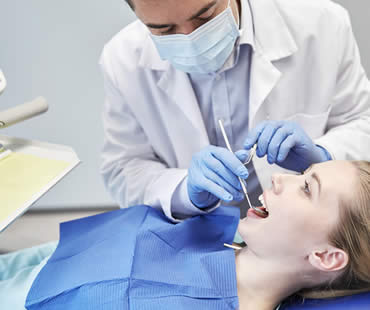
If you didn’t have your wisdom teeth out as a young person, you may be wondering about having them out as an adult. Your dentist may have recommended that you prevent future infections, cysts or pain in the jaw due to wisdom teeth that are growing under other teeth – known as impacted teeth. Even a type of tumor has been linked to impacted wisdom teeth.
Impacted teeth result when the wisdom tooth grows up under an existing tooth. Sometimes, adults have wisdom teeth that come in completely straight behind back molars. In rare cases, one or more of these teeth don’t grow at all. An x-ray can reveal the presence of the teeth. Impacted teeth cause problems with existing teeth and must come out.
Because the roots of wisdom teeth typically fully develop near the age of 24, removing them after this time can be more complicated. Roots can entwine with facial nerves, making extraction problematic. It’s recommended that adults receive a CT scan of their jaw, showing the clear positioning of facial nerves and roots, something not shown by x-rays. If the roots of the lower wisdom teeth aren’t touching or wrapped around the alveolar nerve, extraction is still possible.
Adults with wisdom teeth are at higher risk for gum disease. Gum disease has been linked to an increase of pregnancy complication and other health issues. Previously believed only to affect patients in their late 30s, this gum disease is now being shown to affect much younger patients, especially young pregnant women. Growing evidence is also connecting gum disease to inflammation due to chronic infections in the body, leading to an increased risk of diabetes and heart disease.
Talk to your dentist today to see if you should have your wisdom teeth removed. Be honest about any symptoms you’re having, such as pain or pressure, and let the professional evaluate your specific situation.
If you live in the Ottawa area contact us today

Cosmetic dentistry is becoming an increasingly popular option for improving not only the appearance of your smile but your overall self-confidence. If you are considering cosmetic dentistry as a means to better both your smile and your image, the following may answer some of your most common questions:
What can cosmetic dentistry fix? Cosmetic dental treatments and procedures can fix a multitude of issues including crooked, gapped, stained, discolored, broken, or missing teeth.
How do I locate a qualified cosmetic dentist? Search for a dentist who is accredited with the American Academy of Cosmetic Dentistry (AACD). Inquire about a potential dentist’s training and experience with the treatments you are seeking, as well as referrals and photos from previous patients who have undergone the same procedures.
What are some common cosmetic dental procedures and treatments? Porcelain veneers, composite bonding, dental implants, teeth whitening, and tissue sculpting are all examples of cosmetic options available to improve your smile.
How long will the process take to achieve a better smile? The length of time varies dependent on the type of procedure or treatment and also on your individual needs. However, many cosmetic procedures can be completed in as little as one or two dental visits.
How can I preview what my new smile will look like? Modern technology allows your cosmetic dentist to use computer-aided imaging and models to show the potential of your new smile.
How long can I expect my improved smile to last? With proper oral care and consistent visits to your dentist, most cosmetic dental treatments and procedures can last for many years and even decades.
With the help of cosmetic dentistry, an improved smile will boost your self-confidence, as well as better your overall oral function and health. Consult with an accredited cosmetic dentist to develop a treatment plan that addresses your specific cosmetic concerns and get ready to greet the world with a bright, new smile!
If you need a dentist in Ottawa contact us today

Sedation dentistry, also known as “sleep dentistry,” refers to the practice of calming and relaxing a patient prior to a dental procedure with the use of pharmacological agents. Sedation dentistry began in the late 1700s when a chemist named Humphry Davy began experimenting with inhaled gasses and first observed the analgesic effects of nitrous oxide, commonly known as “laughing gas,” on himself and on dental patients.
In 1844, an American dentist named Horace Wells used nitrous oxide as a dental anesthetic during the extraction of his own molar tooth. Wells made the observation that while he experienced very little pain while undergoing the extraction, he was still fully conscious during the procedure. A few years later, dentist William Morton and surgeon John Warren performed a public oral surgery at Harvard University, demonstrating the analgesic properties of a sulfur-ether compound, further proving that sedation dentistry should be explored further.
For years, trial and error procedures informed doctors of the safety of various levels of pain-relieving gasses. It was discovered that 100% nitrous oxide, when used in prolonged dental cases, could lead to hypoxia, a condition in which the body is deprived of the oxygen it needs to thrive, something that can eventually lead to death. Finally, a Chicago surgeon named Dr. Edmund Andrews began mixing nitrous oxide with oxygen, administering them simultaneously. This allowed for safer analgesic options for both surgical and dental procedures. Ether and chloroform, combined with some nitrous oxide, was later shown to provide deeper sedation for prolonged treatments.
Intravenous (IV) sedation began in the 1960s at the Loma Linda University School of Dentistry in California. Dentists there experimented with IV sedation for the highest level of management for pain, anxiety and fear for dental patients undergoing surgery.
Today, dentists routinely turn to sedation dentistry for their patients to relieve pain, stress and to provide the most comfortable dental therapies as possible. Talk to your dentist to discover the latest sedation dentistry options and to see how they can help you positively experience your next dental procedure.
If you need a dentist in Ottawa contact us today

If you have severely damaged, diseased or injured teeth, your dentist may recommend crown and bridge treatment. A crown is a dental restoration that fully covers a tooth and becomes the tooth’s new outer surface. A bridge is also a dental restoration that is anchored to natural teeth. However, a bridge replaces and fills the gap left by multiple missing teeth. Both crowns and bridges are made from a variety of materials and can be matched to the color of your natural teeth. Unlike removable dental devices like dentures, crowns and bridges are permanently affixed to existing teeth or implants allowing them to look and function similarly to natural teeth.
In addition to restored function and appearance, crowns and bridges offer a host of additional benefits including:
- Dental crowns protect and strengthen the natural tooth, helping you to avoid extraction.
- Crowns are the final step in root canal treatment, protecting the tooth from bacteria that could re-infect the treated tooth.
- Crowns and bridges restore missing teeth and support the remaining teeth.
- Your natural bite is restored and maintained with crown and bridge treatment.
- Placement of crowns and bridges improve your speech, smile and chewing function.
- Adjacent teeth are prevented from shifting and tilting with crown and bridge treatment.
- Crowns and bridges are long-lasting, predictable and durable.
- Placement of crowns and bridges is quick and can usually be completed in as little as two appointments.
- Alternatives to crown and bridgework, like dental implants, are usually more invasive requiring surgery and possibly bone grafting to place the implant.
Consult with your dentist to find out more about the advantages of crowns and bridges and how they can help to restore your healthy smile.
Our dental office is located in Ottawa

Pain, sensitivity, and trouble eating or sleeping are only a few of the uncomfortable symptoms of a damaged tooth. Sometimes the inside portion of a tooth, or its pulp, becomes so damaged that action must be taken. It could come in the form of extracting the tooth or it might be able to be saved through root canal treatment.
Virtually every dentist recommends root canal therapy over tooth extraction. It’s almost always better to save your natural tooth. Otherwise, you’ll end up with a hole in your smile and the problems that accompany it.
A tooth can be damaged for a variety of reasons such as severe decay, trauma, or deep cavities. The damaged pulp contains nerves, which is one reason that many patients experience severe pain. Although dental fillings can remedy some cavities or decay, when the situation advances to the extent of harming the tooth pulp, fillings are not enough. Root canal treatment is usually the best way to repair the tooth without having to pull it.
A root canal procedure involves drilling into the tooth so that the pulp can be completely removed and the canal thoroughly cleaned. Then the area is filled with special material and sealed to prevent future damage. Often, a dental crown is placed on top of the restored tooth to provide added protection. This process alleviates any symptoms and give you back your fully functional, natural tooth.
If you were to opt for tooth extraction instead of root canal treatment, you’d be choosing a more invasive approach. The procedure can be intrusive, time consuming and costly. Recovery from tooth extraction can be uncomfortable and take longer than root canal therapy. Careful oral hygiene is necessary after extraction to avoid infection or complications. You’ll also be left with an unappealing hole in your smile that can make eating and speaking more difficult, and your other teeth will likely start moving into that empty space.
To determine the best treatment for you, consult a reputable dentist. You’ll learn about the options and how root canal therapy may be the best choice in restoring your oral health and your smile.
We treat patients from Ottawa and the surrounding area

Whitening your teeth to improve your smile is a popular cosmetic treatment, but you should understand that it does have some limitations to consider. If products are used correctly or if you seek the professional help from a qualified dentist, you can usually achieve a bright and appealing smile. Here are some things to think about when it comes to teeth whitening.
Methods:
You should not expect over-the-counter methods to whiten your teeth more than a couple of shades. The whitening ingredients available in products at your drugstore are not as strong as those used at your dentist’s office. Consistent and correct use of over-the-counter options can help whiten your teeth, but it may not be as much as some patients hope will occur. On the other hand, professional methods can produce dramatic and quick improvements to the color of your teeth.
Habits:
Certain habits contribute to stains on your teeth and if you don’t limit or stop activities prone to discoloring teeth, your newly whitened teeth may become discolored again. Foods like berries and curry, drinks such as coffee and red wine, and habits like smoking will all likely negatively affect your tooth color.
Restorations:
Bridges, crowns, and laminates might not respond in the same way to whitening agents as your natural teeth do. Ask your dentist about how your restorations might react to teeth whitening.
Side effects:
Tooth sensitivity is the most common side effect of whitening procedures, causing some patients to be unable to handle some methods of treatment. Gum sensitivity is another potential problem, but usually dissipates soon after the whitening procedure. Weakening of a restoration may also occur during whitening treatment, sometimes making it necessary to replace them.
Expectations:
Teeth whitening must be occasionally repeated if you want your bright smile to remain for a lifetime. The effects do not last indefinitely, because aging and activities can stain your teeth. Excessive bleaching may damage your teeth though, so be sure to discuss your whitening treatment with your dentist.
Our dental office is located in Ottawa







